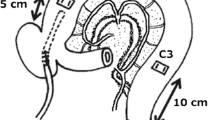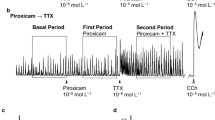Abstract
Severe bacterial infection causes gastrointestinal dysmotility by an unknown mechanism. We investigated the possible involvement of serotonin (5-HT) and nitric oxide (NO) in endotoxin-induced motility disturbance, using an in vivo rat model. Six days prior to the experiment, a force transducer was sutured to the gastric antrum of rats. Lipopolysaccharide induced strong repetitive contractions in the gastric antrum within 2 to 3 min in all rats tested. After 15 min of hypermotility, motility decreased and remained low for more than 60 min. The initial increase in motility was suppressed by atropine, FK1052, or SB204070, whereas it was not affected by granisetron. The subsequent decrease was inhibited by l-NAME and S-methylisothiourea sulfate. These results indicate that in conscious rats, lipopolysaccharide induces a transient increase in gastric motility followed by suppression. The increase might be mediated by 5-HT4 receptors, and the decrease by inducible NOS.
Similar content being viewed by others
REFERENCES
Dale DC, Petersdorf RG. Septic shock. In Harrison's Principles of internal Medicine, 11th ed. E Braunwald, KJ Isselbacher, RG Petersdorf, JD Wilson, JB Martin, AS Fauci (eds.). New York, McGraw-Hill, 1983, pp 474–478
Esplugues JV, Whittle BJR: Mechanisms contributing gastric motility changes induced by PAF-acether and endotoxin in rats. Am J Physiol 256:G275–G282, 1989
Wirthlin DJ, Cullen JJ, Spates ST, Conklin JL, Murray J, Caropreso DK, Ephgrave KS: Gastrointestinal transit during endotoxiemia: the role of nitric oxide. J Surg Res 60:307–311, 1996
Takakura K, Hasegawa K, Goto Y, Muramatsu I: Nitric oxide produced by inducible nitric oxide synthase delays gastric emptying in lipopolysaccharide-treated rats. Anesthesiology 87:652–657, 1997
Okumura T, Shoji E, Takahashi N, Wakebe H, Imagawa K, Kikuchi M, Kohgo Y: Delayed gastric emptying by Helicobacter pylori lipopolysaccharide in conscious rats. Dig Dis Sci 43:90–94, 1998
Cullen JJ, Caropreso DK, Ephgrave KS: Effect of endotoxin on canine gastrointestinal motility and transit. J Surg Res 58:90–95, 1995
Cullen JJ, Caropreso DK, Hemann LL, Hinkhouse M, Conklin JL, Ephgrave KS: Pathophysiology of adynamic ileus. Dig Dis Sci 42:731–737, 1997
Tomomasa T, Takahashi A, Kaneko H, Watanabe T, Tabata M, Kato M, Morikawa A: Y-27632 inhibits gastric motility in conscious rats. Life Sci 66:29–34, 2000
Hellstrom PM, al-Saffer A, Ljung T, Theodorsson E: Endotoxin actions on myoelectric activity transit, and neuropeptides in the gut. Role of nitric oxide. Dig Dis Sci 42:1640–1651, 1997
Haga N, Suzuki H, Shiba Y, Mochiki A, Mizumoto A, Itoh Z: Effect of TKS159, a novel 5-hydroxytryptamine 4 agonist, on gastric contractile activity in conscious dogs. Neurogastroenterol Motil 10:295–303, 1998
Mine Y, Yoshikawa T, Oku S, Nagai R, Yoshida N, Hosoki K: Comparison of effect of mosapride citrate and existing 5-HT4 receptor agonists on gastrointestinal motility in vivo and in vitro. J Pharmacol Exp Ther 283:1000–1008, 1997
Wilmer A, Tack J, Coremans G, Janssens J, Peeters T, Vantrappen G: 5-hydroxytryptamine-3 receptors are involved in the initiation of gastric phase-3 motor activity in humans. Gastroenterology 105:773–780, 1993
Tamura T, Sano I, Satoh M, Mizumoto A, Itoh Z: Pharmacological characterization of 5-hydroxytryptamine-induced motor activity (in vitro) in the guinea-pig gastric antrum and corpus. Eur J Pharmacol 308:315–324, 1996
Nakajima M, Shuiihara Y, Shiba Y, Sano I, Sakai T, Mizumoto A, Itoh Z: Effect of 5-hydroxytryptamine on gastrointestinal motility in conscious guinia-pigs. Neurogastroenterol Motil 9:1–10, 1997
Nagakura Y, Ito H, Kamato T, Nishida A, Miyata K: Effect of selective 5HT3 receptor antagonist on gastric motility in fasted and fed dogs. Eur J Pharmacol 327:189–193, 1997
Doebber TW, Wu MS, Robbins JC, Choy BM, Chang MN, Shen TY: Platelet activating factor (PAF) involvement in endotoxin-induced hypotension in rats. Studies with PAFreceptor antagonist kadsurenone. Biochem Biophys Res Commun 127:799–808, 1985
Pons L, Droy-Lefaix MT, Braquet P, Bueno L: Role of free radicals and platelet-activating factor in the genesis of intestinal motor disturbances induced by Eschericha coli endotoxins in rats. Gastroenterology 100:946–953, 1991
Caplan MS, Hedlund E, Adler L, Lickerman M, Wei H: The platelet-activating factor receptor antagonist WEB2170 prevents neonatal necrotizing enterocolitis in rats. J Pediatr Gastroenterol Nutr 24:296–301, 1997
Spain DA, Wilson MA, Bar-Natan MF, Garrison RN: Role of nitric oxide in the small intestinal microcirculation during bacteremia. Shock 2:41–46, 1994
Gauthier TW, Davenpeck KL, Lefer AM: Nitric oxide attenuates leukocyte-endothelial interaction via P-selectin in splanchnic ischemia–reperfusion. Am J Physiol 267:G562–G568, 1994
Uno N, Hailong W, Menconi MJ, Tytgat SHAJ, Larkin V, Smith M, Morin MJ, Chavez A, Hodin RA, Fink MP: Inhibition of inducible nitric oxide synthase ameliorates endotoxininduced gut mucosal barrier dysfunction in rats. Gastroenterol 113:1246–1257, 1997
Salzman AL: Nitric oxide in the gut. New Horiz 3:33–45, 1995
Szabo C, Soouthan GJ, Thiemermann C: Beneficial effects and improved survival in rodent models of septic shock with Smethylisothiourea sulfate, a potent and selective inhibitor of inducible nitric oxide synthase. Proc Natl Acad Sci USA 91:12472–12476, 1994
Eskandari MK, Kalef JC, Billiar TR, Lee KKW, Bauer AJ: LPS-induced muscularis macrophage nitric oxide suppresses rat jejunal circular muscle activity. Am J Physiol 40:G478–G486, 1999
Torihashi S, Ozaki H, Hori M, Kita M, Ohota S, Karaki H: Resident macrophages activated by lipopolysaccharide suppress muscle tension and initiate inflammatory response in the gastrointestinal muscle layer. Histochem Cell Biol 113:73–80, 2000
Author information
Authors and Affiliations
Rights and permissions
About this article
Cite this article
Watanabe, T., Tomomasa, T., Kaneko, H. et al. Involvement of Serotonin and Nitric Oxide in Endotoxin-Induced Gastric Motility Changes in Conscious Rats. Dig Dis Sci 47, 1284–1289 (2002). https://doi.org/10.1023/A:1015366329568
Issue Date:
DOI: https://doi.org/10.1023/A:1015366329568




